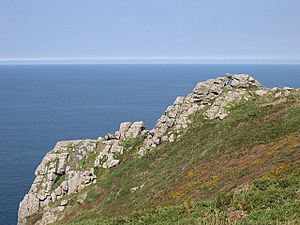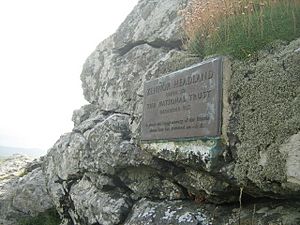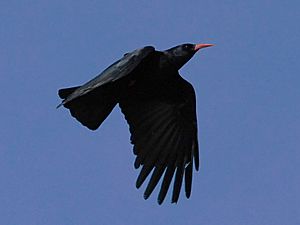Zennor Head facts for kids
Quick facts for kids Zennor Head |
|
|---|---|

Zennor Head, looking north
|
|
| Type | Promontory |
| Location | Cornwall |
| Nearest city | Zennor |
| Etymology | Saint Senara |
| Operated by | National Trust |
Zennor Head is a long piece of land that sticks out into the sea in Cornwall, England. It's about 750 meters (2,460 feet) long. This special place faces the Atlantic Ocean. You can find it about 1 kilometer north-west of the village of Zennor.
The cliffs at Zennor Head are made of granite. They rise over 60 meters (200 feet) from the water. The highest point of the headland is 96 meters (314 feet) above sea level. There's a special marker there called a triangulation station. Zennor Head is part of the famous South West Coast Path. This walking path follows the edge of the cliffs. The headland is also part of the Penwith Heritage Coast. It's the biggest coastal area in the United Kingdom that starts with the letter "Z"! Its name comes from a local saint, Senara. People used to mine for copper and tin here a long time ago. Today, no one lives or works on the headland. But it's home to many coastal animals and plants. You might see kestrels flying or gorse bushes growing.
What's in a Name?
The name "Zennor Head" comes from a local saint. Her name was Senara.
A Look Back in Time
The edges of Zennor Head have old stone walls called Cornish granite hedges. The way people farmed here started around 4000 BC. That was during the Bronze Age in Cornwall. The area around Zennor has been lived in for over 4,000 years.
In the 1800s, people dug a lot for copper and tin at Zennor Head. You can still see old drainage tunnels on the eastern side. These tunnels helped remove water from the mines.
In December 1953, Zennor Head was given to the National Trust. This group helps protect special places. The South West Coast Path was created in 1978. It runs along the top of Zennor Head. This path is 630 miles (1,014 km) long. It follows the cliff edges very closely. A book called Zennor in Darkness by Helen Dunmore was partly set around Zennor Head. This book won an award in 1994. In 2009, the headland had some flooding. This affected the footpath along the cliffs. Zennor Head is also part of the Penwith Heritage Coast. This means it's a protected area because of its natural beauty.
Land and Rocks
Zennor Head is on the north coast of Cornwall, England. It faces the huge Atlantic Ocean. This headland stretches out about 750 meters (2,460 feet). It has very steep cliffs that drop into the sea. It is west of St Ives and north-east of Penzance. The closest village is Zennor.
Two small bays are on either side of the headland. They are called Pendour and Porthzennor. The next headland over is Gurnard's Head. It's about 1.6 kilometers (1 mile) to the west. You can get to Zennor Head from the South West Coast Path. Or you can use the B3306 road, which is a coastal road. On the western side, there's a deep inlet called Horseback Zawn. Many seabirds build their nests there. The highest point of the headland has an Ordnance Survey "Trig Point". This marker helps mapmakers.
The rocks you see at Zennor Head are mostly "Killas" strata. These are sedimentary rocks. They formed between 415 and 375 million years ago. Zennor Head is also where the "Land's End Granite" begins. This granite formed about 279 to 274 million years ago. When the hot granite pushed into the Killas rocks, it changed them. They became a type of shale.
Animals and Plants
Zennor Head is home to many different animals and plants. You might see the Cornish chough, a special bird. Grey seals have also been seen swimming off the coast. Many seabirds nest on the cliffs. This is especially true around Horseback Zawn. These birds include herring gulls and fulmars. Kestrels hunt for food on the land near the shore.
The headland is mostly covered with grass. You can also find heather and bracken plants. Other plants like thyme and western gorse grow here too. In 1962, a rare plant called western clover was found at Zennor Head. A type of lichen called Dirina massiliensis also grows on the cliffs. You might also spot a parasitic plant called dodder. It grows on gorse bushes. Other common coastal flowers include kidney vetch, sea campion, and thrift.
Images for kids










